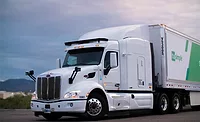Distribution
Planning for vehicle retirement
Key considerations for retiring old vehicles and replacing them with new ones

It’s never too early to start thinking about retirement — of your vehicles, that is. And it’s a no-brainer that every company should have a succession plan of sorts in place for your fleet equipment.
“The factors on truck replacement should be part of a strategic fleet plan — they are a complex set of decisions based on a number of factors,” says Chuck Davis, director of sales at PacLease, PACCAR’s leasing division.
Too many companies, Davis says, simplify this decision and base it on two criteria: vehicle age and miles, often referred to as a company replacement cycle. While these are, of course, important considerations, a number of other data points should factor in to the strategic plan. The first is engine life, which varies greatly in medium- and heavy-duty engines. The next is the number of stops the vehicle experiences, which can be hard on equipment components and the overall life of the truck.
The third factor is engine hours. Idle time doesn’t show up the odometer, but it can be converted to miles to better understand engine wear. Fourth is a balanced fleet age.
“It is important not to end up with a high percentage of your fleet in only a couple of year models,” Davis says. “This results in lower costs while the fleet is new, but the fleet becomes an older fleet all around the same time, resulting in not only extremely high costs, but more down time, which leads to driver dissatisfaction and harm to company image.”
Finally, Davis advises determining what benefits you are missing or would gain with new technology — everything from fuel economy, safety and driver morale to reduced downtime and operating costs.
“These benefits could overcome all other criteria,” Davis points out, “but are often the last considered.”
When it comes to devising a maintenance schedule for the lifetime of a vehicle, there’s no one-size-fits-all approach. The obvious starting place should always be to listen to the manufacturers recommendations for normal operation. Then, you have to look at your own specific operation of those vehicles to determine whether you need more or less maintenance.
“For example, if you’re operating inner city with numerous stops, you’ll want to inspect service and park brakes more often and set up more frequent service to lube all of the moving parts associated with those stops,” Davis advises. “Each new vehicle you add to the fleet or, better yet, each vehicle you are considering for the fleet should be customized to your operation based on the job to be done, expected life components and service intervals.”
Today’s vehicles, he notes have many sealed systems that do not require service. And, while oil and lubes can last a lot longer, the key to a successful maintenance program is the inspection.
“We’ve all known of people who have seen a doctor, found a condition in early stages and everything turned out well,” he says. “This is true for trucks too, but you must inspect to find them and we all know results have the potential to be worse for late-stage conditions.”
Davis offers three final pieces of advice related to vehicle “retirement” planning:
- Formalize a quarterly asset management review of the fleet’s key performance indicators (KPIs): costs, downtime, unscheduled repairs, age and miles.
- Keep informed of new technology and invest in maintenance software that can track and report KPIs.
- Keep communication open with drivers by always responding to their input because they’re the real eyes and ears of your fleet.
Looking for a reprint of this article?
From high-res PDFs to custom plaques, order your copy today!






